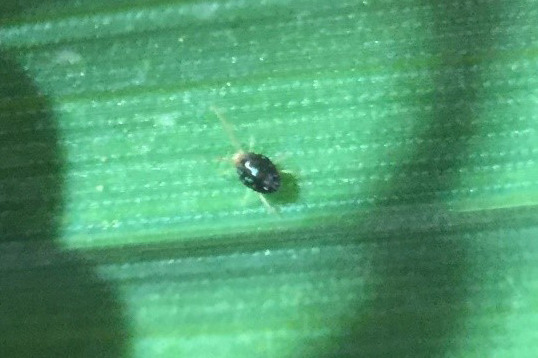Managing your grazing cereals to maximise production - Insects
By Callen Thompson, Senior Local Land Services Officer – Mixed Farming
While many producers in the Central west are still waiting, some areas have been lucky and have had enough rain to sow forage and dual purpose cereals. By now these crops should be well and truly up and growing and many producers are probably thinking about stocking them. There are a number of management practices you can do to optimise crop growth and therefore livestock production. Over the next few articles, I discuss some of the important post sowing activities.

This week we will focus on insect control as I have recently found Blue oat mites and corn aphids in a paddock near Coonabarabran, unfortunately my own!
Blue oat mites (BOM) and to a lesser extent, red legged earth mites (RLEM), are the first thing to look for when you step into the paddock. In high enough numbers BOM and RLEM can cause major damage to cereal crops as well as canola and legumes. I have seen many cases where BOM have caused establishment failure in oats as well as pasture. Even when the crop has established they can significantly reduce dry matter yield, especially if the crop is moisture stressed.
Both BOM and RLEM are tiny and very difficult to see so it is a good idea to take a hand lens with you. They are both black (BOM are a Blue-Black while RLEM are jet black) with red legs. BOM have a red spot on their abdomen while RLEM do not. Both insects feed by scraping the cuticle of the leaf with their grinding mouthparts. This gives the leaf a slightly silver look.
BOM and RLEM can be controlled chemically. The insecticides used are relatively cheap and compatible with some of the common in crop herbicides, but it is worth speaking to your agronomist before you spray as some species are resistant to different chemicals.
 Russian Wheat Aphid (RWA) was first identified in Northern NSW last year and could be an issue for producers growing early sown wheat or barley as they carry over on host plants, particularly volunteer cereals and barley grass. RWA injects toxins into the plant during feeding which stunts plant growth. Heavy infestations may kill plants.
Russian Wheat Aphid (RWA) was first identified in Northern NSW last year and could be an issue for producers growing early sown wheat or barley as they carry over on host plants, particularly volunteer cereals and barley grass. RWA injects toxins into the plant during feeding which stunts plant growth. Heavy infestations may kill plants.
Detection of RWA is most likely by seeing symptomatic plants infected plants may have leaves with white, yellowish and red streaks as well as leaf rolling along margins. If you can see symptoms in the plant inspect for aphids. Russian wheat aphid is very small so use a hand lens to examine them. RWA are generally light green in colour, with an elongated body shape, distinctive black eyes and lack visible ‘exhaust pipes’ (siphunculi). There is chemical options for control, but with all chemical applications check the label for grazing withholding periods. For more information on RWA go to:
Oat aphid and corn aphids can reduce dry matter yields by sucking moisture and nutrients from the crop, this will be particularly detrimental to moisture stressed crops. Aphids can also spread barley yellow dwarf virus (BYDV), again reducing biomass. There is some varietal difference in tolerance to BYDV so check your winter crop sowing guide.
When you are deciding whether or not to spray for insect pests, it is important to take into account the number of insect pests, the crops ability to tolerate the pest, economic thresholds and the number of predators present. If in doubt talk to your agronomist. As mentioned already, always read the label and do not graze within grazing withholding periods.
NSW DPI has a great Primefact on grazing cereals which can be found here:
If you would like more information on grazing cereal crops, contact your Local Land Services Ag Advisor.
Images: Corn aphid (top) and blue oat mites (bottom) can limit forage production, particularly in a dry year.